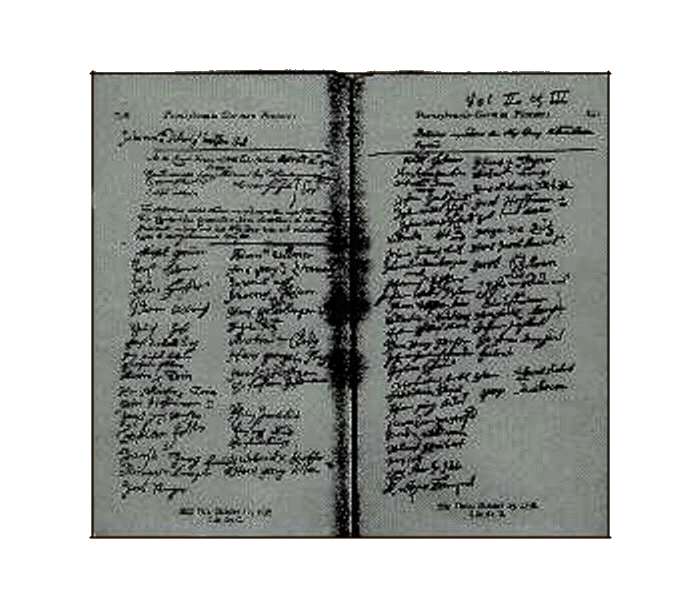

 |
 |
| Ship's log for the "Davy" | Sailing ship, perhaps like the "Davy" |
A Brief History Of The Shrum Family
The oldest reference to the surname Shrum (Schramm, Schrum, Shram, etc.) that I have found, is a census from Norway in 1250 BC.
The name can be traced back to Brandenberg, the historical
birthplace of Brandenberg-Prussia; which was named after the Slavic chieftain
Brendenburg. Brandenberg eventually incorporated Westphalia, Saxony, Pomerania,
Silesia, and Hessen.
The family name of Schramm was prevelent in
Prussia and Silesia, and were prominate contributors to the development of the
regions, as well as being recognized as prominate in social affairs.
In the 16th & 17th centuries, the name Schramm was found in Nurenberg
and Offenbach in Bavaria, as well as the Rhineland-Pfalz region. Among notable
family branches of the surname are the Schramm Von Protzen in Prussia, and the
Schramm Von Otterfield in Austria. Members of the Schramm family were elevated
to nobility during the 19th century in 1808 and 1817. The Schramm family name
also represented a Parisian branch of nobility, when they became counts of the
French Empire in 1813 and 1841. A notable member of the Schramm family was
Joseph Schrammel (1850-1893), a composer, who invented a form of quartet (two
violins, a guitar, and an accordion) that bears his name.
During
the Thirty Years War (1618-1648), a family named Barth lived in the village of
Altenkirchen(a province of Kusel, Chur-Pfalz region of Rhineland-Pfalz, later
known as the Palatinate). In the later years of the war, groups of soldiers were
roaming the countryside, pillaging, burning, and taking whatever they could. The
Barth family, with thier young daughter Apolonia, fled from the area for saftey
(census records from Altenkirchen for the later years of the war confirm that
the population dropped from 120 to 28). It is not known where they fled
to,(perhaps the village of Strasbourg,France; which had a huge population of
Schramm's living there, just about a hundred miles north of Altenkirchen) but
when they returned to Altenkirchen, Apolonia Barth had brought Peter Schramm
back with her. (Barth family lore has it that the young couple had to wait a
number of years to marry, untill the clergy returned to the area). From the
1640's until the present, this Schramm family branch has always resided in
Altenkirchen.
Peter Schramm and Apolonia Barth had six children:
My ancester; Hanss Theobaldt Schramm, was born 1644 in Altenkirchen. He married Anna Liess in 1699, and they had five children:
Johann Jacob Schramm married Anna Maria Kreafer
in 1714. Together, they boarded a ship called the "Davy" in Rotterdam,
Holland and sailed via Cowes, England for America. They arrived in the port of
Philedelphia with their surving children on October 25th, 1738. (The year of
1738 had been so devastating to German emmigrants, that they named it "The Year
Of The Destroying Angels", after Psalms 78, verse 49: "He let loose on them his
fierce anger, wrath, indignation, and distress; a company of destroying
angels".(See "Beyond Germanna" by Klaus Wust;
http://homepages.rootsweb.com/~marier/Germanna.htm for the complete
story of the hardships endured by the German emmigrants). The next day, The
Philedelphia Gazette revealed the horrible story of the ill-fated voyage; "The
Captain, both mates, and 160 passengers died at sea. The ship's carpenter,
William Patton, brought the ravaged vessel up the Deleware." The ship had sailed
less than a year before being lost. Patton listed 74 men and 47 women as
survivors (He listed no children). Only 40 men were well enough to take the oath
of alliegence to become American citizens, among them were Johann Jacob
Schramm and his surving sons Nikel (Nicholas) Schramm and David
Theobaldt Schramm. Anna Maria's will in 1754 mentions as heirs:
George, David, Nicholas and Johannes (born in America).
The other children must have perished at sea.
Jacob and Anna
Maria settled near York, Pennsylvania where Jacob died in 1748. Anna Maria died
near there in 1754. They have markers at Prospect Hill Cemetary in York, PA.